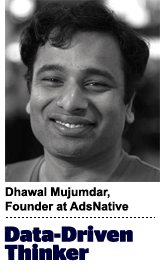 “Data-Driven Thinking” is written by members of the media community and contains fresh ideas on the digital revolution in media.
“Data-Driven Thinking” is written by members of the media community and contains fresh ideas on the digital revolution in media.
Today’s column is written by Dhawal Mujumdar, founder at AdsNative.
The only way to create the ads of the future is by staying on top of emerging trends.
Digital advertising needs to keep pace in the post-PC world of smartphones, live-streaming apps and virtual reality devices. As predefined banner ads take a back seat, more malleable ads that change size, shape and aesthetics based on device and context will become the norm.
Given the buzz surrounding wearable devices, next-gen and live-streaming apps, advertisers may be tempted to dive in headfirst. But with just about any new app or device, there will be the inevitable limitation, which is why marketers should experiment with many different technologies and creative strategies.
Live-streaming apps such as Meerkat and Periscope have become all the rage in the past few months. But the major challenge here is that the nature of live streaming doesn’t leave many natural breaks for ads. Advertisers may find more success with product placements, launches and endorsements.
Madonna, the queen of reinvention herself, recently debuted a promo of her upcoming music video using Meerkat. Advertisers should follow the Material Girl’s example by spending more time on experimentation and setting up dedicated studios and labs.
Likewise, Hollywood studios can uses live-streaming apps to promote shows and create excitement. For example, while marketing “Game of Thrones,” HBO could run a live stream of the shooting of the upcoming season directly from the show’s set and offer a sneak peek of future episodes. This could create quite a clamor among the show’s fans, driving interest and ramping up loyalty.
Once live-streaming apps reach the necessary scale, they offer rich, interest-based data that can be used in promotions and ad targeting. This data on audience interests – gathered via users’ viewing habits and their engagement on social media platforms like Twitter, Snapchat or Vine – can be used in a variety of ways, such as in promoted streams, which appear in users’ feeds.
This data can also help marketers determine what kind of live-streaming experiences are sought by specific audience segments. As Alex Frias explained in Forbes, “Curation will be half the battle; the other half will be centered on giving their community the social authority to take a brand’s DNA and make it their own. Live Q&As, social contesting, consumer promotions and influencer marketing all just gained an essential shiny new tool in their toolboxes.”
No Easy Task
Despite these advantages, live-streaming apps come with their own challenges. Some argue that the immediacy of the data collected via these apps poses legal risks, with people’s “right to publicity” possibly being violated. Companies that fail to obtain consent from the people featured in their commercial footage could be sued by those individuals; perhaps more frightening is the potential of being sued by other businesses whose copyrights have been infringed upon.
To promote continued purchases, advertisers should also consider allocating more experimental budgets toward next-gen consumer apps and platforms and approaching ad tech companies and the app makers themselves with campaign proposals.
A campaign may include, for example, a marketer showing a contextually relevant ad to a consumer who just bought dinner on a food delivery app like GrubHub or Seamless. The ad could promote a product while providing a discount on delivery charges or future orders. With a simple request to try out the experiment, you could make your ads fit into the push-button paradigm of what some call real life’s remote control.
Bypassing The Limitations
In the same way live-streaming apps don’t have natural breaks for ads, every next-gen platform comes with its own limitations. However, when advertisers are engaged with any new platform, they can understand its salient features and find ways to bypass irritating limitations.
Social media platforms, such as Facebook and Instagram, have autoplay videos that are muted by default. This posed a challenge for advertisers, including Hotels.com, which performed a clever workaround with an American Sign Language interpreter and humorous subtitles, generating buzz around the brand.
The data limitations can be overcome with some savvy planning. Companies can collect better data by using live-streaming apps that don’t immediately remove a recording upon a broadcast’s completion, such as Periscope. Offering the aforementioned curation tools — Q&A sessions, contests and promotions — can also ensure that brands gather data beyond a live stream’s lifetime. And if these brands utilize contests and influencer marketing, they can control the material provided by offering guidelines, ensuring that the associated data avoids inflicting damage while providing insight into audiences’ preferences and interests.
The more advertisers understand a platform, the more they can get out of it. To get consumers’ attention, advertisers will need to come up with unique ways to leverage the latest technology in their advertising campaigns and collect data to determine what consumers engage with and how they interact on these devices. With experimentation as a top priority, advertisers can create the kind of ads people want to see.
No marketer wants to be the one who fails to prepare for future possibilities. They should dive deep into the latest technology and learn as much as possible. In a world with billions of people using the Internet, they need to be ready to capitalize on the next opportunity that consumers can’t live without.
Follow AdsNative (@AdsNative) and AdExchanger (@adexchanger) on Twitter.












